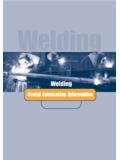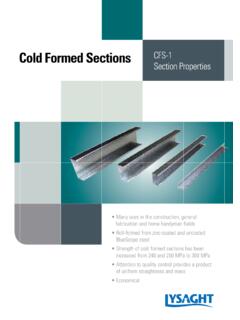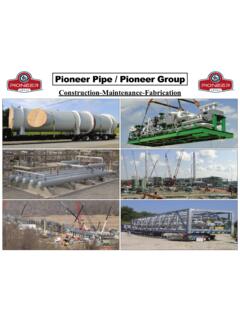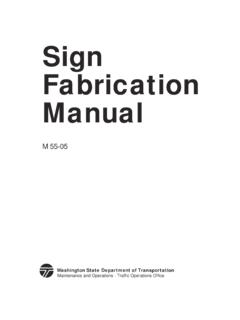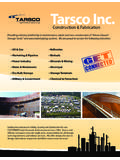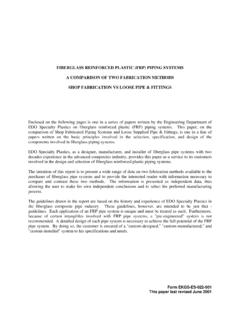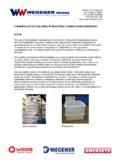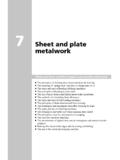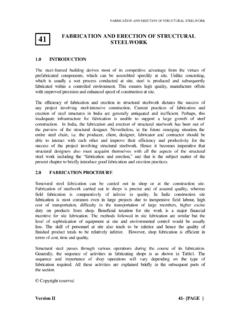Transcription of Useful Fabrication Information Bending
1 Forming & Forming & BendingUseful Fabrication InformationBendingMany plate applications require that the steel be formedto varying extents ranging from simple cold Bending in apress brake to deep drawing in complex, multi-stage diepresses. The latter is a specialist process outside thescope of this note, however, the metallurgical principlesinvolved and some general guidelines appropriate to themore conventional forming operations are chemical composition, mechanical properties,metallurgical microstructure, surface condition,thickness, edge condition, and forming direction inrelation to the rolling direction of the steel, will have aninfluence on the plate forming Forming involves plastic deformation, or stretching,of the material surface on the outside of the bend. Theextent to which this plastic deformationcan take placewithout exceeding the limits of the material ductility,controls the minimum radius of bend which can beutilised for a particular plastic deformation associated with cold formingresults in strain hardening of the material and this in turnaffects the mechanical properties.
2 In the areas subject tothis plastic deformation, ductility and fracturetoughnessdecrease. For certain critical applications it may benecessary either to restrict the radius of the bend tominimise these effects, or even to undertakesubsequent heat treatment to restore the major factors affecting the extent to which formingis possible without failure are:1. Steel typeLow strength steels are generally more ductile thanhigher strength steels and are therefore capable ofbeing shaped to more restrictive forming radii. Materialproduced to AS/NZS 3678 and AS/NZS 1594 by BlueScope Steel are fully killed steels with good homogeneity and microstructural cleanness which impartsgood formability. Product data sheets give Information onminimum bend radii. Generally low carbon content is aprerequisite to good formability and higher carbon steelshave limitations in this Direction of Forming Relative to thePrincipal Rolling Direction of the PlateThe properties of steel plates are, directionallydependant by virtue of the rolling process duringmanufacture, which elongates the metallurgicalstructure, inclusions, etc parallel with the principal rollingdirection (ie.)
3 Length direction) of the (and indeed all steel products), will thereforeexhibit different mechanical and physical propertiesdepending on the orientation relative to the originalrolling direction. The extent of this directionalitydependence of properties varies with steel type, steelmill rolling practice and product size and shape, but themost favourable forming properties will generally beobtained in the longitudinal, or principal steel mill rollingdirection. Ductility of steel plates follows this rule and forthis reason plates are more readily formed, or stretched,with the bend axis transverse to the principal rollingdirection of the plate. Because of reduced ductility, Bending with the axis parallel to the principal rollingdirection of the plate will normally necessitate largerbend recommended cold Bending radii on individualgrades refer to BlueScope Steel Product data sheets for the Edge and Surface ConditionSteel ductility can be reduced significantly by thepresence of local stress raising influences.
4 For thisreason the removal of sharp corners on sheared edges,gouge marks on flame cut edges and other similarstress - concentrating sources on either the edge or thesurface, should precede cold forming. Attention to the"outside" or tension side of the edge or surface is mostimportant in this respect, particularly in thicker platewhere it is necessary to utilise restrictive bend radii. Forsuch applications, careful examination of the edge andsurface prior to Bending is or similar methods should be employed toremove gouge marks, notches, heavy scoring, andsharp edges. Similarly, the Iocalised edge hardeningassociated with shear cut edges and flame cutting, mayimpair the cold Bending performance of the plates. Forparticularly critical applications it may be necessary toapply some form of edge conditioning to remove partiallythe metallurgically affected edge of edges and removal of sheared edge arrisis forming is to be carried out without prior removalof the sheared edge arris, positioning of the componentwith the arris on the inside, or compression side of thebend will reduce the risk of failure during Other Practical FactorsForming dies should exhibit chamfered corners andopenings.
5 The provision of liberal die radii, consistentwith the finished component, will minimise excessivelocal strains and thereby reduce the risk of risk of failure on forming heavy plate thicknesses orparticularly restrictive bends may be somewhat reducedby preheating the plate (to about 75 C) prior to is particularly applicable to plate thickness above20mm where the outer fibres of the tension face of theplate are subject to triaxial stress states by virtue of thebulk surrounding material. Brittle failure can result fromsuch conditions and mild heating of the plate will reducethe tendency to failure. For similar reasons, formingshould not be undertaken where the plate temperatureis below 15 C. Formed plate components will generallyexhibit springback on removal of the die or bendingpress force. This springback is due to the release ofelastic strain energy and the magnitude of this strain isdirectly related to the yield strength of the material. Forthis reason a slightly greater "overbending" allowanceshould be made for high yield strength FormingJULY 2000 Notes:1.
6 The recommended minimum Bending radii offloorplate are as above except where the raised patternis in tension, when a more liberal radii should be used. 2. A transverse bend is one where the axis of the bend is at right angles to the direction of rolling3. A longitudinal bend is one where the axis of thebend is parallel to the direction of Hot forming - refer comments under "Hot Forming."-- Press forming Roll forming1AS/NZS 1594/HU2002AS/NZS 1594/HU250, HA2503AS/NZS 1594/HU300, HU300/14AS/NZS 1594/HU350 Recommended Minimum Internal Radiusof Cold Bends in FormingMinimum Bend Radius (mm)Strip Thickness (mm)Table1 Recommended Minimum Inside Radius for Cold Bending of Plate Grades During Fabrication (1)For most structural applications, the extent of strainhardening and consequent increase in strength withreduction in toughness and ductility resulting from coldworking, need not warrant specific attention. For certainmore critical applications however, or where particularprocessing is to be carried out subsequent to coldforming, it may be necessary to adopt alternativeprocedures.
7 On most hot rolled plates mechanicalproperties can be restored by a normalising heattreatment, typically at 900 C, followed by air treatment eliminates all traces of cold , such a "cold form-normalize" cycle may not beappropriate to controlled rolled steels which rely on steelmill rolling practice to attain their mechanical treatment of such steels (especially microalloyedsteels) may significantly lower the mechanical propertiesand should not be undertaken except with restoration of properties and reduction of theresidual stresses inherently associated with cold formingmay be obtained with a stress relief heat treatment,typically at 600 vessels, heat exchangers and boilers,including those utilising steel plates to AS1548, aregenerally subject to specification, or statutory authorityrequirements in respect of heat treatment after coldforming and hot forming. Reference to the appropriatespecification (AS 1210) or authority is recommendedbefore such processing of these ageing is a metallurgical phenomenon whereby adelayed increase in strength, and loss of ductility andtoughness occurs in susceptible steels as a result ofstrains induced by cold working.
8 The ageing changesare both time and temperature dependent, and proceedvery slowly at ambient temperatures. Exposure of aseverely cold worked steel plate to elevatedtemperatures (up to about 450 C) may, however, resultin an unacceptable loss of ductility, and may require thatthe component be subjected to additional heat treatmentto restore acceptable mechanical properties. The extentto which strain ageing occurs depends on a largenumber of factors including steel type, thickness, degreeof cold work, etc. Welding of plate material adjacent toareas which have been severely cold worked may resultin the area undergoing a thermal cycle sufficient toresult in a reduction of toughness and ductility due tothe mechanism of strain ageing. Welds on orimmediately adjacent to cold worked regions of plateshould be avoided if possible for this combined effects of hydrogen embrittlement duringacid pickling, and strain ageing due to the thermaleffects of hot dip galvanising, may result in unacceptablylow ductility of cold worked and galvanised relieving, or preferably normalising isrecommended prior to galvanising of cold workedcomponents which are to be subjected to any significantdegree of stress in service.
9 Brittle failure at quite lowstresses can occur if this precaution is not observed,particularly where cold Bending is carried out using asharp edged forming refers to deformation carried out at atemperature (usually near 900 C) such that the strainhardening and the distorted grain structure produced bythe process are rapidly eliminated by the formation ofnew strain free grains via a mechanism known asrecrystallisation. Very large deformations are possible inhot working because the recovery processes keep pacewith the deformation. Therefore a much greater degreeof forming may be carried out with hot working than withcold working. Additionally, because the strength of steeldecreases with increasing temperature,the total energy(or press capability) necessary to deform a givencomponent will be much lower for hot working than forcold working. Hot forming is therefore appropriate toplate applications where the required deformation isgreater than that attainable with cold forming (eg.)
10 Certainpressure vessel heads). Hot forming may also be adesirable alternative to cold forming where presscapacity is are, however, certain limitations to hot high temperatures involved often mean that surfaceoxidation (or scaling) and surface decarburisation maybe a problem. It may also be difficult to avoid rolling orpressing into the plate surface, the scale producedduring the hot forming operation. Due allowance mustbe made for thermal expansion and contraction in steel plate grades rely on controlled thermo-mechanical processing at the steelworks in order toestablish their mechanical properties. These includeAS/NZS 3678-350, WR 350 and impact tested grades(where plates are tested in the as-rolled condition). Suchgrades have their mechanical properties modifiedmarkedly by heat treatment or hot forming above 600 Cand are therefore not readily amenable to suchprocessing without specialist a general rule plates should not be soaked forprolonged periods above 950 C, and it is preferable tohot form within normalising range near 900 of ColdFormed ComponentsHot Forming1800 800 19 000 019 625

